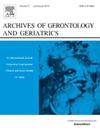Effects of different movement velocities during resistance training on bone mineral density in older adults: A systematic review and meta-analysis
IF 3.5
3区 医学
Q2 GERIATRICS & GERONTOLOGY
引用次数: 0
Abstract
Objective
To investigate the effects of different movement velocities during progressive resistance training (PRT) on bone mineral density (BMD) in older adults, with an emphasis on program design and training principles.
Methods
Seven databases were comprehensively searched to identify studies investigating the effect of PRT at different movement velocities on BMD. The primary outcome was BMD at fracture-relevant sites measured by dual-energy X-ray absorptiometry (DXA). Meta-analysis of within-group changes was conducted using a random-effects model.
Results
Of 1830 screened records, 9 studies met the inclusion criteria. No statistical comparison was possible regarding movement velocity. However, the findings suggest benefits of incorporating high-velocity movements. The analysis revealed that moderate-velocity programs frequently failed to prevent bone loss. In terms of program design, significant benefits of variation in PRT programs were observed. Moreover, the interventions demonstrated substantial interindividual variability in efficacy.
Conclusion
High-velocity PRT effectively enhanced BMD when overarching training principles were met. Nevertheless, further research is required to confirm the superior efficacy of high-velocity training. Moreover, individualization is essential since responses to programs vary, prompting questions about underlying differences. Considering that osteoporosis involves defective mechanotransduction, factors beyond established confounders may influence the intervention's efficacy.
阻力训练中不同运动速度对老年人骨密度的影响:一项系统回顾和荟萃分析
目的探讨进行性阻力训练(PRT)中不同运动速度对老年人骨密度(BMD)的影响,重点探讨方案设计和训练原则。方法综合检索7个数据库,找出不同运动速度下PRT对骨密度影响的研究。主要结果是通过双能x射线吸收仪(DXA)测量骨折相关部位的骨密度。采用随机效应模型对组内变化进行meta分析。结果在1830份筛选记录中,有9项研究符合纳入标准。没有关于移动速度的统计比较。然而,研究结果表明,结合高速运动是有益的。分析显示,中速运动经常不能防止骨质流失。在程序设计方面,观察到PRT程序变化的显著益处。此外,这些干预措施在疗效上表现出显著的个体差异。结论在满足总体训练原则的前提下,高速PRT能有效提高骨密度。然而,需要进一步的研究来证实高速训练的优越效果。此外,个性化是必不可少的,因为对项目的反应各不相同,这引发了关于潜在差异的问题。考虑到骨质疏松涉及有缺陷的机械转导,既定混杂因素之外的因素可能会影响干预的效果。
本文章由计算机程序翻译,如有差异,请以英文原文为准。
求助全文
约1分钟内获得全文
求助全文
来源期刊
CiteScore
7.30
自引率
5.00%
发文量
198
审稿时长
16 days
期刊介绍:
Archives of Gerontology and Geriatrics provides a medium for the publication of papers from the fields of experimental gerontology and clinical and social geriatrics. The principal aim of the journal is to facilitate the exchange of information between specialists in these three fields of gerontological research. Experimental papers dealing with the basic mechanisms of aging at molecular, cellular, tissue or organ levels will be published.
Clinical papers will be accepted if they provide sufficiently new information or are of fundamental importance for the knowledge of human aging. Purely descriptive clinical papers will be accepted only if the results permit further interpretation. Papers dealing with anti-aging pharmacological preparations in humans are welcome. Papers on the social aspects of geriatrics will be accepted if they are of general interest regarding the epidemiology of aging and the efficiency and working methods of the social organizations for the health care of the elderly.

 求助内容:
求助内容: 应助结果提醒方式:
应助结果提醒方式:


